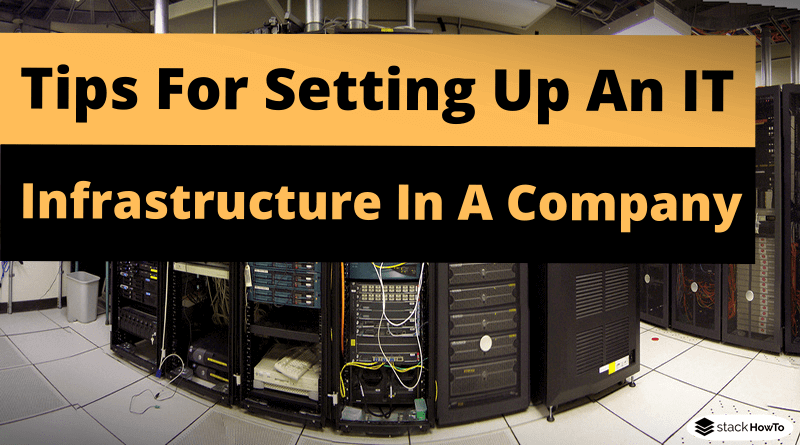Tips For Setting Up An IT Infrastructure In A Company
The digitization of the economy is advancing savagely, so that even SMEs in various niches, but also in traditional crafts, are no longer safe from it. Since the know-how around IT systems is often in short supply in such companies, the step into the digital sphere often turns out to be complex and expensive.
But in times of extensive standardization, it no longer has to be. With a little research and a little background knowledge, a small infrastructure can be set up quickly.
In order for this to work effectively, this article has a few tricks and explanations ready to help you make the right decision and ensure a future-proof implementation. It is a good insight into some aspects of the daily work of IT specialists for system integration.
Aspiring IT professionals or those interested in this industry can benefit from these tips. But even small companies that want to set up a computer system themselves should take them to heart.
Determine your own, individual requirements

Every company has very special, individual requirements that also have a direct impact on the requirements for the IT systems. There are many different factors that determine what shape the computer network will take:
- Size: The number of employees is an important factor. Even those who do not access the systems directly on a regular basis increase the requirements that the network must meet. In particular, the number of clients that can be active at any time determines the necessary performance of the server and network.
- Growth: Companies can grow noticeably even in a short period of time, which ultimately has an impact on the requirements for computer systems. In most cases, it is therefore important to focus on scalability in planning in order to be able to meet the changed requirements in the future. A certain degree of flexibility in the system is therefore necessary – individual components that would have to be adapted in the event of changes should be easily exchangeable or upgradeable. Even a simple extension must be able to be implemented without disruption.
- Industry: What kind of data is processed and, above all, what is the expected volume? Is digital archiving of old files and other documents and photos also being considered in the course of digitization? The more demanding they are, the more the backend server must be able to handle them. If, on the other hand, large files such as high-resolution graphics are increasingly being processed at the workplace, the individual client computers must be equipped accordingly.
- Necessary software solutions: Which data processing systems are used? Usual programs that are mainly text and table-based, such as CRM, ERP, email, project management tools, customer interfaces, and the respective operating systems – in most cases Windows 10 Pro or Enterprise – have rather low system requirements, while specialized software often also has the corresponding computing power desire.
- Budget: Different companies not only have different infrastructure requirements, but also a noticeably different budget. The total costs can vary greatly depending on the form and complexity of the IT infrastructure. The amounts that can or want to be invested in IT therefore take a large part of the decisions in many cases.
Cloud: Yes or No?

Opinions are divided on this question. While cloud computing appears to be the model of the future in many ways, it has not yet arrived in business reality for many services. Various advantages and disadvantages of cloud computing or on-premises structures are difficult to weigh up.
Basically, it means the decision whether the software systems in the company are operated on their own servers and computers in the office buildings, or whether a service provider is commissioned to do this in large server centers and make the data and programs accessible via the Internet.
A trend that is particularly useful for fast-growing companies with flexible data processing requirements is infrastructure-as-a-service. The basic model of cloud-based software-as-a-service, on the other hand, is basically applicable to all types of companies.
Build your organizational structure

Maintaining an on-premises infrastructure is not entirely trivial, especially since the maintenance and scalability of the systems must be considered in the further course. Therefore, careful planning of the individual components in the network is important, as is a clean implementation that prevents future work.
Structured cabling is the ideal case in order to facilitate networking in the building even across several floors. But regardless of whether this is the case or whether improvised cabling with a greater potential for chaos is used, one thing is important: Make sure that there is no risk of confusion or confusion under any circumstances.
The maintenance and servicing of IT systems are much easier when the entire structure is clearly documented and labeled. Labeled stickers that clearly identify the networked end devices and connecting elements are therefore mandatory on all devices that are active in the network and in particular on each connected cable. This will avoid confusion
All computers, servers, switches, cables, and patch panels should be labeled accordingly. Servers often have slide-in label carriers, but these are located on the front – when working on the cabling, additional markings on the back make every move easier. Digital documentation of the network structure, in which the marking designations can be traced, helps with an overview.
Ideally, the network ID, connected devices, and IP address should be legible on the labels. Network components should have appropriate markings on both the cables and the associated ports. This is clearly distinguishable and extremely durable.
Such colored markings on ports and connections can also be helpful for individual PCs at workstations, so that first level support can help even inexperienced users more easily over the phone.
Redundancy
Unlike a private environment, failures of any kind in companies are usually absolutely unacceptable. Therefore, it is important to attach great importance to security with redundancies. This is applicable to several aspects:
- Power: If a power failure affects the server, it can lead to prolonged incapacity for work, in the worst case to the loss of important data. Therefore an Uninterruptible Power Supply (UPS) is an absolutely essential investment.
- Data storage: Big data is the keyword. The storage and processing of mass data are becoming increasingly important in all sectors. Therefore, sufficient memory redundancy should be planned for the constantly growing amounts of data.
- Backups: Backup copies of all relevant business data are vital for many companies in an emergency. Several forms of redundancy are optimal – in addition to several storage media, a geo-redundant backup database is very effective. This is located in a different location so that it remains unaffected by physical threats such as water damage.





